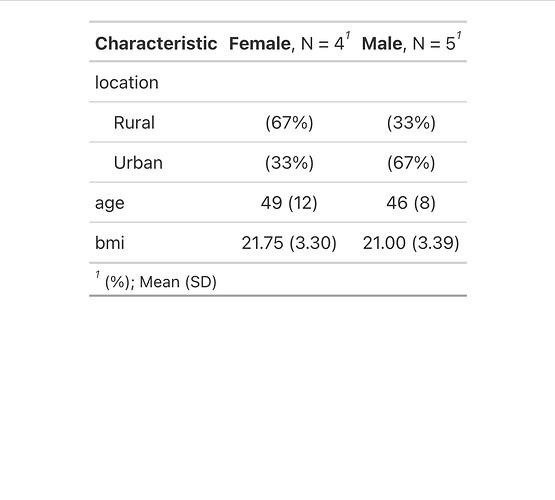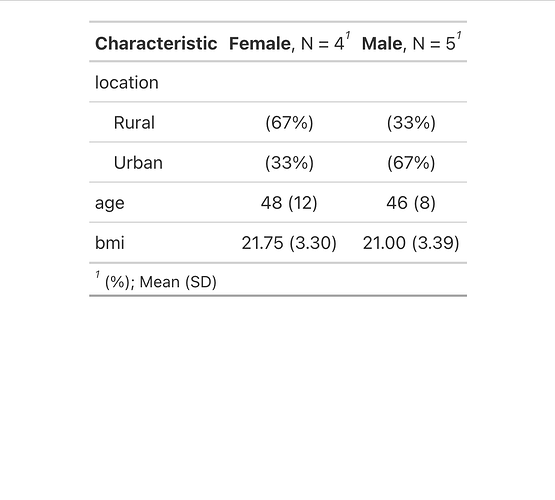Great reprex.
Here's a solution that exploits the structure returned by tbl_summary to locate where the mean needs changing to weighted.mean and it doesn't involve tidyr::uncount() at all.
library(gtsummary)
#> #BlackLivesMatter
# pattern to detect part of a string before a space or (
pat <- "^.* "
# obtain pw weighted mean age for a sex
get_wm <- function(x) {round(weighted.mean(d[which(d$sex == x),5],
d[which(d$sex == x),2]),0)
}
d <- data.frame(id = c(1, 2, 3, 1, 2, 3, 1, 2, 3),
pw = c(207, 188,41,32,137,86,170,213,135),
sex = as.factor(c("Male","Female","Female","Male","Male",
"Female","Female","Male","Male")),
location = as.factor(c("Rural","Rural","Urban","Urban","Urban",
"Urban","Rural","Urban","Urban")),
age = c(39, 34, 44, 37, 53, 61, 57, 46, 54),
bmi = c(21, 18, 20, 17, 22, 24, 25, 19, 26))
# prepare table with unweighted mean age
o <- d[,-c(1,2)] |>
tbl_summary(by = sex, percent = "row",
statistic = list(all_continuous() ~ "{mean} ({sd})",
all_categorical() ~ "({p}%)"),
type = c(age, bmi) ~ "continuous")
# inspect
# enter this to see where the target object was found
# str(o)
# substitute weighted mean ages in summary table
o$table_body$stat_1[4] <- sub(pat,paste(get_wm("Female"),""),o$table_body$stat_1[4])
o$table_body$stat_2[4] <- sub(pat,paste(get_wm("Male"),""),o$table_body$stat_2[4])
Created on 2023-04-22 with reprex v2.0.2
gtsummary produces html markup that doesn't display well here, so here is the before
table as an image
with a mean of 49, and here is the after table with a mean of 48 as an image
Rationale: school algebra—f(x)=y where
x is the object at hand, in this case the data frame d.
y is the desired object, a tbl_summary nested lists with a print method to format as the presentation table created with the first tbl_summary() call *with the exception that the age row display the return value of weighted.mean() rather than mean().
f is the chain of functions (composite function) to transform x into y.
Most of the work is already done by the first tbl_summary() call. Then, using str(o) (o is for object, as d is for data frame) we find
str(o)
# List of 8
# $table_body : tibble [5 × 7] (S3: tbl_df/tbl/data.frame)
# {snip}
o is a named list and its first element, named table_body is a tibble and we can extract that by name o$table_body. Scrolling down we come to what we are looking for in terms of where the values are to be changed.
..$ stat_1 : chr [1:5] NA "(67%)" "(33%)" "49 (12)" ...
..$ stat_2 : chr [1:5] NA "(33%)" "(67%)" "46 (8)" ...
which we can refer to as o$table_body$stat_1 and ...stat_2.
Let's examine the first
o$table_body$stat_1
# [1] NA "(67%)" "(33%)"
# [4] "49 (12)" "21.75 (3.30)"
It's a five element character vector, and the fourth element, which contains the mean value to be changed is element 4, which is the character string "49 (12)" All that needs to be changed is the value before the space. (If sd is to be similarly adjusted, both would need be.)
Within that string are the characters 49 separated by a space character from the following characters enclosed in (). The first can be identified by the pat regular expression—zero or more characters at the beginning followed by a space. Having drilled down to the mean value to be replace, there remains only the replacement.
get_wm does the weighted.mean() calculation for the entire data frame by Sex without the trouble of uncount(), and that is used as the replacement in sub(). The final fussiness of paste() is just to restore the space.

